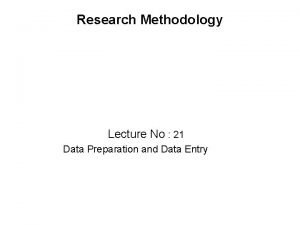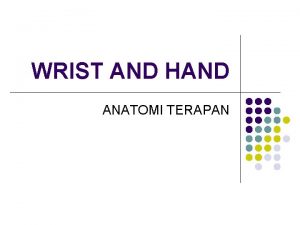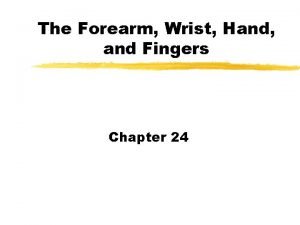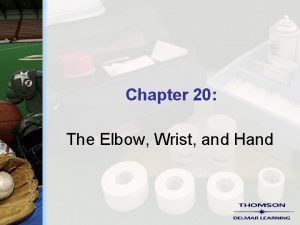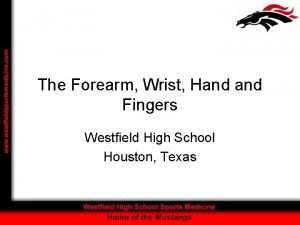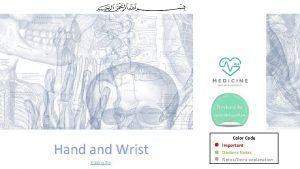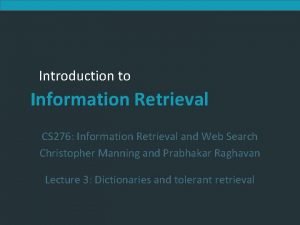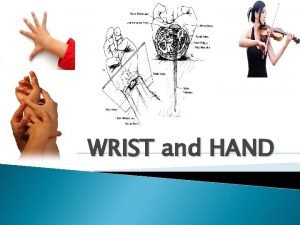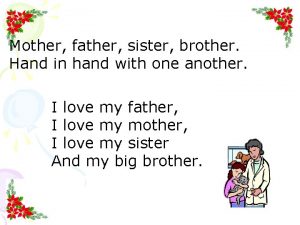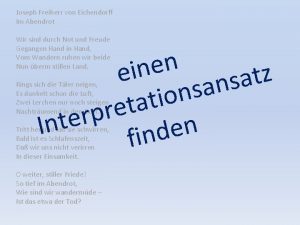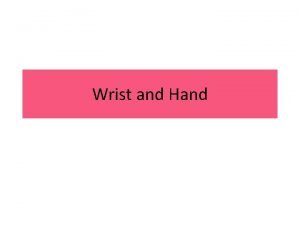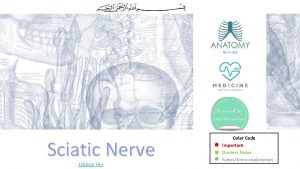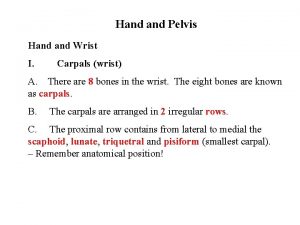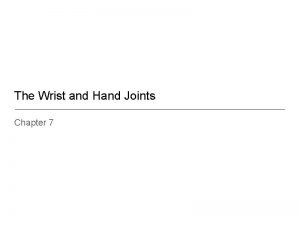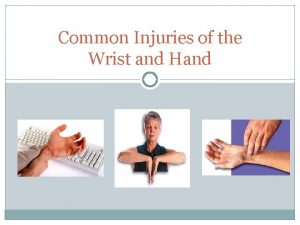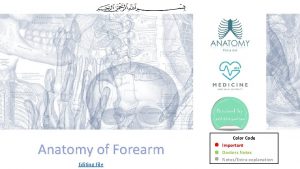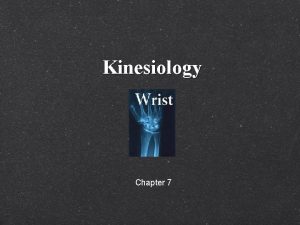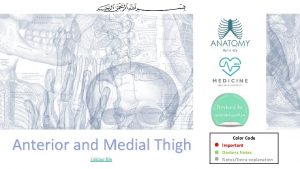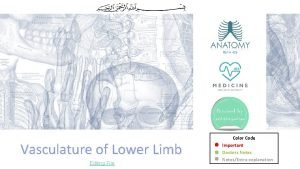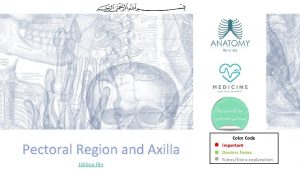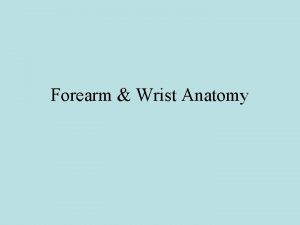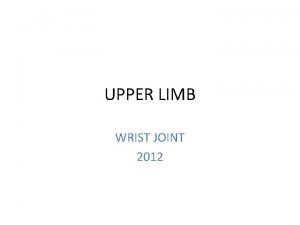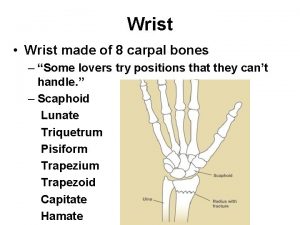Hand Wrist Editing file Color Code Important Doctors























- Slides: 23

Hand Wrist Editing file Color Code Important Doctors Notes/Extra explanation

Objectives üDescribe the anatomy of the deep fascia of the wrist & hand (flexor & extensor retinacula & palmar aponeurosis). üList the structures passing superficial & deep to flexor retinaculum. üDescribe the anatomy of the insertion of long flexor & extensor tendons. üDescribe the anatomy of the small muscles of the hand (origin, insertion, action & nerve supply)

Recall what we took in foundation: The following pairs always come together (they counter each other so if one is present so is the other) Flexor & Extensor (flexor carpi ulnaris & extensor carpi ulnaris) Longus & Brevis (extensor carpi radialis longus & extensor carpi radialis brevis) Superficialis & Profundus (flexor digitorum superficialis & flexor digitorum profundus) Major & Minor (pectoralis major & pectoralis minor) The fingers: Digitorum = has 4 tendons each attached to a finger Pollicis = the thumb Indices = index finger ﺍﻟﺴﺒﺎﺑﻪ Digiti minimi = pinkie Index

Retinacula Flexor & Extensor Retinacula: Bands of Deep Fascia at the Wrist Function: Hold the long flexor and extensor tendons at the wrist in position. Attachments: Medially Laterally Flexor retinaculum Pisiform & Hook of hamate Tubercle of scaphoid & Trapezium Extensor retinaculum Pisiform & Hook of hamate Distal end of radius Extra

Structures Superficial to Flexor Retinaculum From Medial to Lateral 1. Tendon of Flexor carpi ulnaris. 2. Ulnar nerve. 3. Ulnar artery. 4. Palmar cutaneous branch of ulnar nerve. 5. Palmaris longus tendon. 6. Palmar cutaneous branch of median nerve.

Carpal Tunnel Formed from Concave anterior surface of the Carpus (carpal bones) covered by Flexor Retinaculum. Contents From Medial to Lateral • Tendons of flexor digitorum superficialis & profundus • Median nerve • Flexor Pollicis Longus • (Flexor carpi radialis) * Note the flexor carpi radialis is in between brackets because it has a special compartment in the fascia

Carpal Tunnel Syndrome Causes : • Compression of the median nerve within the carpal tunnel. Manifestations: 1. Burning pain (pins and needles) in the lateral three and half fingers. No paresthesia* over thenar eminence (because it is supplied by the plamer cutaenous branch of the median which is superficial to the flexor retinaculum) 2. Weakness or atrophy of thenar muscles (Ape Hand). 3. Inability to Oppose thumb. *Paresthesia: a sensation of pricking, tingling, or creeping on the skin usually associated with injury or irritation of a sensory nerve or nerve root

Palmar Aponeurosis: o The thickened deep fascia of the palm. o It is triangular in shape, occupies the central area of the palm. o It has: • Apex: attached to the distal border of flexor retinaculum and receives the insertion of palmaris longus tendon. • Base: divides at the bases of the fingers into four slips that pass into the fingers. o Function: 1. Firmly attached to the overlying skin and improves the grip (it’s deeply concave and not superficial in order to hold stuff easily) 2. Protects the underlying tendons, vessels & nerves. 3. Gives origin to palmaris brevis muscle.

Palmaris Brevis: Origin Flexor retinaculum (FR) & Palmar aponeurosis (PA) Insertion Skin of the palm Nerve supply Ulnar nerve (superficial branch) Action Corrugation* of skin to improve grip. (the contractions appear on the skin since it’s a superficial muscle) corrugation*: shaped into alternate ridges and groove

Short Muscles of Thumb & Little Finger: (explained in the next slide) It includes the Thenar eminence and Hypothenar eminence. Each one is further divided into 3 types of muscles. Can be remembered using the mnemonic, "A OF A" for: (thenar muscles) ❖ Abductor pollicis brevis ❖ Opponens pollicis ❖ Flexor pollicis brevis ❖ Adductor pollicis (Hypothenar muscles) ❖ Opponens digiti minimi ❖ Flexor digiti minimi ❖ Abductor digiti minimi

Short Muscles of Thumb & Little Finger: Hypothenar Eminence Muscle Origin Abductor digiti minimi Pisiform Flexor digiti minimi Flexor retinaculum Opponens digiti minimi Flexor retinaculum Insertion Nerve supply Action Abduction Base of proximal phalanx Palmer surface of 5 th metacarpal All by deep branch of ulnar nerve Flexion Pulls the 5 th metacarpal forward

Short Muscles of Thumb & Little Finger: Thenar Eminence Muscle Origin Abductor pollicis brevis Flexor retinaculum, Scaphoid and trapezium Flexor pollicis brevis Flexor retinaculum Opponens pollicis Flexor retinaculum Adductor Pollicis (also on the thumb but not part of thenar) Insertion Nerve supply Action Abduction Base of proximal phalanx All supplied by median nerve Lateral part of 1 st metacarpal Flexion Opposition Origin Insertion Nerve supply Action Oblique head: Anterior bases of 2 nd &3 rd metacarpal. Medial side of base of proximal phalanx of thumb. Deep branch of Ulnar nerve. Adduction. Transverse head : 3 rd metacarpal.

Movements of the Thumb

Insertion of Extra Flexor Digitorum Superficialis & Profundus Flexor Digitorum Superficialis 1 - Each tendon Divides into two halves & pass around the Profundus Tendon. 2 - The two halves Meet on the posterior aspect of Profundus tendon (partial decussation of fibres). 3 - Reunion ( )ﺍﺗﺤﺎﺩ ﻣﻦ ﺟﺪﻳﺪ of the two halves. 4 - Further Division into two slips attached to the Borders of Middle Phalanx. Flexor digitorum Profundus : Inserted into the Base of the Distal Phalanx. 4 2&3 1 Extra picture for understanding

Fibrous Flexor (Digital) & Synovial Flexor Sheaths: Fibrous flexor sheaths: o Fibrous flexor is a strong fibrous sheath which covers 1 the anterior surface of the fingers and attached to the sides of the phalanges. o Its proximal end is opened. o Its distal end is closed. o The sheath with the anterior surface of the phalanges & the interphalangeal joints form an osteofibrous blind tunnel 2 for the long flexor tendons of fingers. 1 Both kinds of sheath covers the tendon to protect it. 2 like a cave ( opened from one side and closed from another ) Synovial flexor sheaths: A - Common synovial sheath (ulnar bursa). o Cover tendons of flexor digitorum superficialis and profundus. o The medial part of it extends distally (without intteruption) on tendons of the little finger. (covers the whole finger) o The lateral part stops on the middle of the palm. (doesn’t cover the 3 middle fingers) o The distal ends of the long flexor tendons to (index, middle and ring) fingers is digital synovial sheaths. (not the ulnar bursa). B - Flexor pollicis longus tendon of the thumb has its own synovial sheath (radial bursa). Function of synovial sheaths: They allow the long tendons to move smoothly with a minimum of friction beneath the flexor retinaculum and the fibrous flexor sheaths. Each finger has a tendon covered by (fibrous flexor sheath) to protect it and between the tendon and the fibrous sheath there are synovial sheaths to reduce friction.

Muscles of the hand Lumbricals (4 muscles) 4 3 2 1 Palmar interossei (4 muscles) 4 Dorsal interossei (4 muscles) 3 2 4 1 Note: you have to differentiate between numbering according to the metacarpals and numbering the digits Index 2 3 1 4 5 1 2 3 4 3 2 1

Muscles of the hand Muscle Origin Insertion Nerve supply Action Lumbricals (4 muscles) Tendons of flexor digitorum profundus Extensor expansion of medial four fingers. Lateral two 1 st & 2 nd by recurrent/digital branch of the median nerve Medial two 3 rd &4 th by the deep branch of the ulnar nerve. Flex metacarpophalangeal joints and extend interphalangeal joints of fingers Except thumb Palmar interossei (4 muscles) 1 st : Base of 1 st metacarpal. Other three: Ant. Surface of Shafts of 2 nd, 4 rd & 5 th metacarpals. * Proximal phalanges of thumb , index, ring, & little fingers and Extensor expansion Deep branch of ulnar nerve Adduction of fingers toward center of the 3 rd one. Dorsal interossei (4 muscles) Contiguous sides of shafts of Metacarpals Proximal Phalanges of index, ring , middle finger & Extensors Deep branch of ulnar nerve Abduction of fingers away from the 3 rd one. Contiguous: adjacent, sharing a common border * The 3 rd metacarpal doesn’t have palmer interossei because it is the axis (does not adduct)

Action of Lumbricals & Interossei Extra Note: the main function of the interossei muscles is abd/adduction but they also assist the lumbricals Note: Reverse the writing position and you get the claw hand (extension of metacarpophalangeal & flexion of interphalangeal) Extra

Extensor Expansion Formed from the expansion of the tendon of the extensor digitorum at the PIJ (proximal interphalangeal joint). The tendon split into three parts: - One Central: inserted into the base of Middle phalanx. - Two laterals: inserted into the base of the Distal phalanx. The Expansion Receives the insertions of: 1. Corresponding Interosseous muscle (on each side). 2. Lumbrical muscle (on the lateral side).

Summary Flexor retinaculum Palmer surface of 5 th metacarpal

Questions 1 - The hypothenar muscles are supplied by: A- Median nerve B- Superficial branch of the ulnar nerve C- Musculocutaneous nerve D- Deep branch of the ulnar nerve 6 - The lateral two lumbrical muscles are supplied by : A-Deep branch of ulnar nerve B-digital branches of the median nerve C-Superficial branch of the ulnar nerve D-axillary nerve 2 - The palmar aponeurosis gives origin to the palmaris longus muscle 7 - The insertion of Dorsal interossei is in : A- True A-Proximal Phalanges of index, ring , middle finger & Extensors B- False B- distal phalanges of index, ring, middle finger & Extensors 3 -There are two other muscles in the palm that are not lumbricals or C-Base of proximal phalanx D- Lateral part of 1 sr metacarpal interossei and do not fit in the hypothenar or thenar compartments: 8 - What is the origin of Adductor Pollicis ? A- Abductor pollicis & Opponens pollicis A- Flexor retinaculum. B- Opponens digiti minimi & flexor digiti minimi B- Pisiform. C-Adductor Pollicis & Palmaris Brevis C- Flexor retinaculum Scaphoid and trapezium. D- Anterior base of 2 nd and 3 rd metacarpals. 4 - which end of fibrous flexor sheath is opened ? A- proximal end 9 - The 2 halves of tendon of Flexor digiti superficialis will meet on : B- distal end A- Anterior aspect of Profundus tendon. C- none of them B- Posterior aspect of Profundus tendon. D- both of them C- Anterior aspect of superficialis tendon. D- Posterior aspect of superficialis tendon. 5 - the function of synovial sheaths is: A- to protect the bone B- Hold the long flexor and extensor tendons at the wrist in position. C- minimum friction D- flexion of the wrist 1 -D 2 -B 3 -C 4 - A 5 - C 6 - B 7 - A 8 - D 9 - B

Questions 10 - A boy injured his median nerve and as a result there was a wasting in thenar muscles. List the muscles affected and the action of each one. 11 - A patient presented with burning pain in the lateral three and half fingers and inability to oppose thumb. What is the most likely diagnosis? Which nerve is affected? 12 - List 4 structures superficial to the flexor retinaculum. Answers: 10 - 1) abductor pollicis brevis (abduction) 2) flexor pollicis brevis (flexion) 3) opponins pollicis (opposition) 11 - Carpel tunnel syndrome. The median nerve is compressed. 12 - 1) ulnar nerve 2) ulnar artery 3) palmer cutaneous branch of ulnar nerve

Leaders: Nawaf Al. Khudairy Jawaher Abanumy Ghada Almazrou anatomyteam 436@gmail. com @anatomy 436 Members: Deena Al. Nowiser Lama Al. Tamimi Norah Alshabib Razan Al. Qahtani Thikrayat Omar Wejdan Alzaid
 Reviews data for consistencies.
Reviews data for consistencies. Nonlinear video editing
Nonlinear video editing File-file yang dibuat oleh user pada jenis file di linux
File-file yang dibuat oleh user pada jenis file di linux Anatomi wrist and hand
Anatomi wrist and hand Chapter 24 the forearm, wrist, hand, and, fingers
Chapter 24 the forearm, wrist, hand, and, fingers Chapter 20 the elbow wrist and hand
Chapter 20 the elbow wrist and hand Hand wrist injury westfield
Hand wrist injury westfield Macam macam end feel
Macam macam end feel Hand color code
Hand color code Cs 276
Cs 276 Code commit code build code deploy
Code commit code build code deploy From most important to least important in writing
From most important to least important in writing From most important to least important in writing
From most important to least important in writing Least important to most important
Least important to most important Difference between logical file and physical file
Difference between logical file and physical file File sharing management system
File sharing management system Distributed file system
Distributed file system What does a markup tag tells the web browser
What does a markup tag tells the web browser In a file-oriented information system, a transaction file
In a file-oriented information system, a transaction file Ulnar paradox
Ulnar paradox Hour hand and minute hand
Hour hand and minute hand Mother father sister brother hand in hand with one another
Mother father sister brother hand in hand with one another What is a use for a worker-machine chart?
What is a use for a worker-machine chart? Alles hat seine zeit gedicht eichendorff
Alles hat seine zeit gedicht eichendorff
